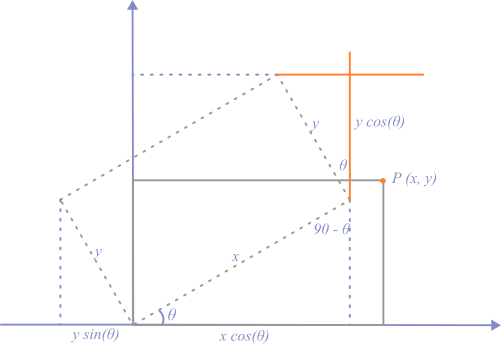Abstract
yes.
-
Install OpenCV (this is only temporary, since we'll use this to read and write images only for now, and later on will switch to Halide)
# the following instructions are for arch # packages and procedures may vary sudo pacman -Sy glew fmt vtk hdf5 opencv # optionally install `zlib` for Halide in case your system doesn't already have it
-
Clone this repo, download and extract the binary release of Halide for your system and place it in the current working directory.
Note: You may have to modify the
CMakeLists.txtfile accordingly.# Add include directories for Halide include_directories(${PROJECT_SOURCE_DIR}/Halide-17.0.1-x86-64-linux/include)Also, make sure you have the
zlibandOpenCVbinaries in your path. -
Build the thing
mkdir build cd build cmake .. make
Stage 1: The naive rotation matrix approach
-
First, we calculate the new dimensions of the image to fit the rotation.

the figure above represents the new size of the image after rotation by an angle $\theta$ -
Next, we decide on a centre for rotation (in this case, the centre of the image $(cx, xy)$), and apply the rotation matrix for each pixel coordinate,
$(x, y)$ of the image $$\begin{bmatrix} x'\ y' \end{bmatrix} = \begin{bmatrix} x - cx\ y - cy \end{bmatrix} * \begin{bmatrix} cos(\theta) & -sin(\theta)\ sin(\theta) & cos(\theta) \end{bmatrix}$$Assuming the centre of rotation of the new image is
$(cx', cy')$ , the final new coordinates are: $$\begin{bmatrix} x'\ y' \end{bmatrix} = \begin{bmatrix} x' + cx'\ y' + cy' \end{bmatrix}$$ -
Finally, we do
pixel_val_at(x', y') = pixel_val_at(x, y)
A lot, but mostly, for now, anti-aliasing. This means, we'll most likely be looking into a multi-pass program.